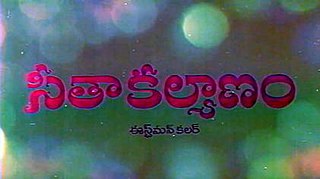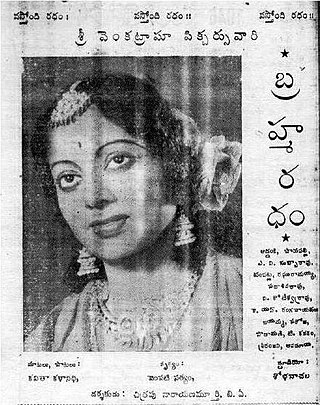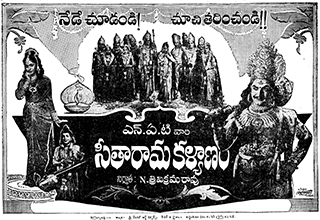
Daana Veera Soora Karna is a 1977 Indian Telugu-language Hindu mythological film co-written, produced and directed by N. T. Rama Rao under his banner Ramakrishna Cine Studios. Based on the life of Karna from the Mahabharata, the film stars Rama Rao in three roles: the title character Karna, Duryodhana, and Krishna. The music was composed by composed by Pendyala Nageswara Rao.

There were eminent mridangam artists like "Mrudanga Kesari" Mullapudi Lakshmana Rao and his son Mullapudi Sri Rama Murty. And his disciple " Mrudanga Shiromani" Dharmala Rama Murty and his son Dharmala Venkateshwara Rao. There were other legends like ML Lakshminarayana Raju and Kamalakara Rao.

Relangi Venkata Ramayya, known mononymously by his surname as Relangi, was an Indian actor, comedian, and producer known for his works predominantly in Telugu cinema. He was honoured with the Padma Shri for his contribution to Indian cinema in 1970. Relangi is particularly known for his comic expressions, and dialogues during the 1950s and 1960s. Together with Ramana Reddy, they were a comedy double act.

Seetha Kalyanam is a 1976 Indian Telugu-language Hindu mythological film directed by Bapu from a screenplay written by Mullapudi Venkata Ramana. It is an adaptation of Ranganatha Ramayanam in Telugu. Based on the Bala Kanda, the ensemble cast film relates events from the birth of Lord Rama, the seventh incarnation of Vishnu, up to his wedding to Seetha, incarnation of Lakshmi.
Kadiri Venkata Reddy, commonly known as K. V. Reddy, was an Indian film director, screenwriter, and producer, primarily known for his work in Telugu cinema. Renowned as one of the most influential filmmakers in South Indian cinema, he directed 14 feature films during his career. His contributions earned him several prestigious accolades, including three National Film Awards and a Filmfare Award South.

Lava Kusa is a 1963 Indian Hindu mythological film directed by C. Pullayya and C. S. Rao. Produced by Lalita Sivajyothi Films, the film is a remake of the 1934 production of the same name, which was also directed by C. Pullayya. The story is based on the Uttara Kanda of the Ramayana, focusing on Lava and Kusa, the twin sons of Rama and Sita. The cast includes N. T. Rama Rao as Rama, Anjali Devi as Sita, with Chittoor Nagayya, Kantha Rao, Sobhan Babu, S. Varalakshmi, and Kaikala Satyanarayana in supporting roles. The soundtrack features 27 songs, with the musical score primarily composed by Ghantasala.

Anjali Devi was an Indian actress, model and producer in Telugu and Tamil films. She was well known for her role as the Devi Sita in Lava Kusa as well as for the title roles in movies like Chenchu Lakshmi, Suvarna Sundari and Anarkali.
Mangalagiri Sriranjani (1906–1939), also known as Sriranjani Senior, was a Telugu theatre and film actress and singer. Born in Narasaraopet Taluk, Andhra Pradesh, she gained fame in the 1930s through her recordings and audio releases with the Gramophone Company of India. Sriranjani was a significant stage actress with Krishna Vilasa Nataka Samajam, known for her portrayal of mythological male roles such as Krishna, Abhimanyu, and Satyavan.

Lava Kusa: The Warrior Twins is a 2010 animation film written and directed by Dhavala Satyam as a joint venture of Kanipakam Creations with RVML Animation.

Sri Seeta Rama Jananam is a 1944 Indian Telugu-language Hindu mythological film, produced and directed by Ghantasala Balaramayya under the Pratibha Productions banner. The film stars Akkineni Nageswara Rao, Tripurasundari, Vemuri Gaggayya, Rushyendramani. Music was jointly composed by Prabhala Satyanarayana and Ogirala Ramachandra Rao. The film marks the debut of Akkineni Nageswara Rao as a lead actor. It is also the debut of Ghantasala as a chorus singer and in a character role. The film was a commercial failure.

Chittajallu Pullayya was an Indian film director and screenwriter. He is one of the earliest film personalities in Telugu cinema being associated with the industry right from the silent era.

Devata (transl. Goddess) is a 1965 Indian Telugu-language drama film, produced by B. Purushottam, presented by comedian Padmanabham on his Rekha & Murali Combines banner and directed by K. Hemambharadhara Rao. It stars N. T. Rama Rao and Savitri, with music composed by S. P. Kodandapani.

Brahma Ratham is a 1947 Telugu drama film directed by Chitrapu Narayana Rao. It is based on the novel of the same name written by Balijepalli Lakshmikantam.
Koccharlakota Satyanarayana was a Telugu film and drama actor and playback singer during the early period of Telugu cinema.

Sri Ramanjaneya Yuddham is a {1975} Indian Telugu-language Hindu mythological film, produced by Potluri Venkata Narayana and SBK Uma Maheswara Rao under the Lakshmi Narayana Pictures banner and directed by Bapu. It stars N. T. Rama Rao, B. Saroja Devi, Ramakrishna and music composed by K. V. Mahadevan. The movie is a remake of 1963 Kannada movie Sri Ramanjaneya Yuddha.

Sita Rama Kalyanam is a 1961 Indian Telugu-language Hindu mythological film directed by N. T. Rama Rao in his directorial debut. It stars N. T. Rama Rao, Haranath, Geetanjali, B. Saroja Devi, Kanta Rao, Sobhan Babu. The film was produced by N. Trivikrama Rao on 'National Art Theatres' banner. The music composed by Gali Penchala Narasimha Rao.

Sampoorna Ramayanam is a 1972 Indian Telugu-language Hindu mythological film directed by Bapu. It is based on Valmiki's Ramayana. The film was a commercial success.

Sampoorna Ramayanam is a 1958 Indian Tamil-language Hindu mythological film directed by K. Somu. It is based on Valmiki's Ramayana. The film stars N. T. Rama Rao in the lead role of Rama and Sivaji Ganesan as Bharatha. It was released on 14 April 1958 and ran for over 264 days in theatres, thereby becoming a silver jubilee hit. The film was dubbed into Hindi as Ramayan in 1960.

Sri Rama Pattabhishekam is a 1978 Indian Telugu-language Hindu mythological film directed and produced by N. T. Rama Rao under Ramakrishna Cine Studios banner. Based on the Ramayana, the film stars Rama Rao, Jamuna and Sangeeta, with music composed by Pendyala Nageswara Rao.

Sita Kalyanam is a 1934 Telugu-language Hindu mythological film directed by Chitrapu Narasimha Rao and produced by Pinapala Venkata Dasu under the banner of Vel Pictures. The film stars Bezawada Rajaratnam, Master Kalyani, and Madhavapeddi Venkatramayya, with music composed by Gali Penchala Narasimha Rao. Released on 6 October 1934, it was a commercial success.
















